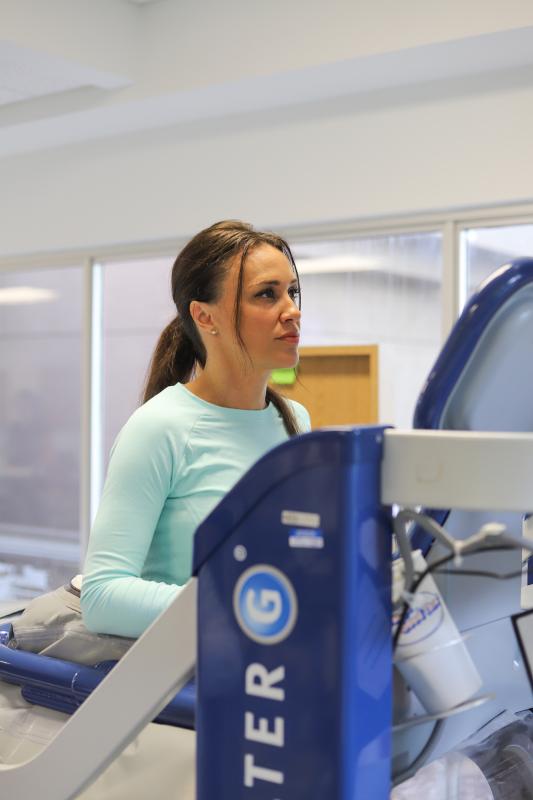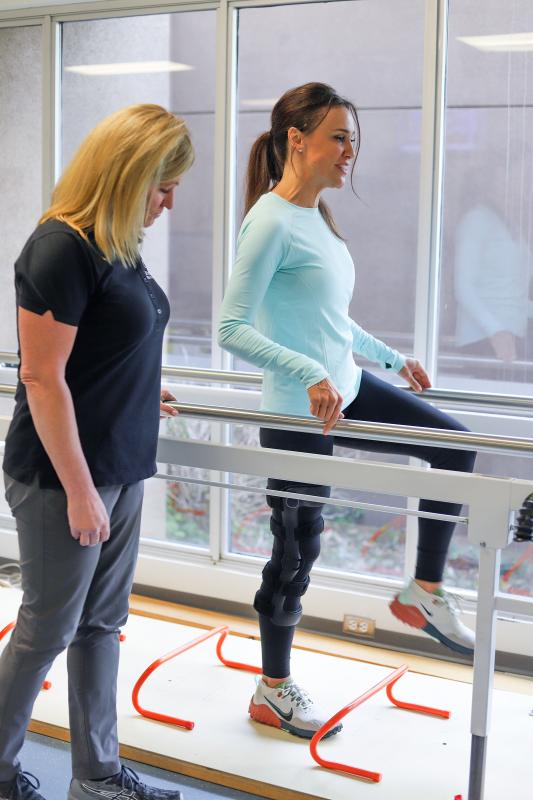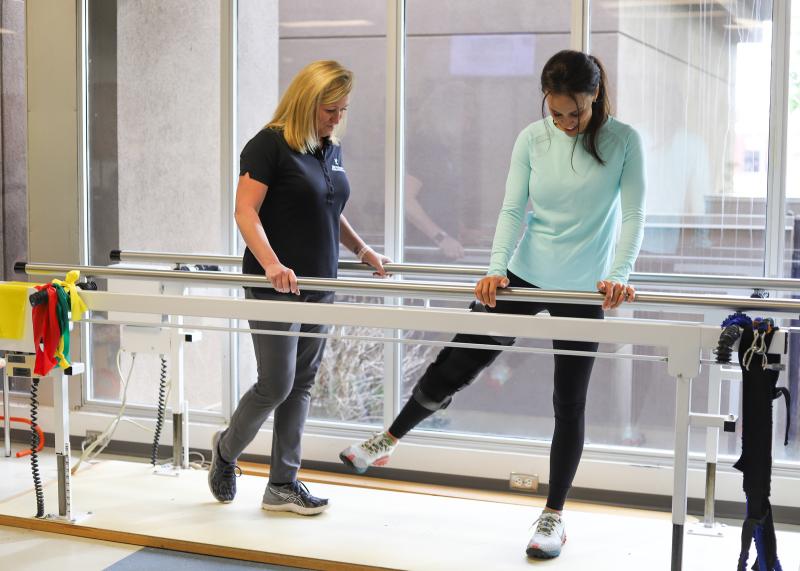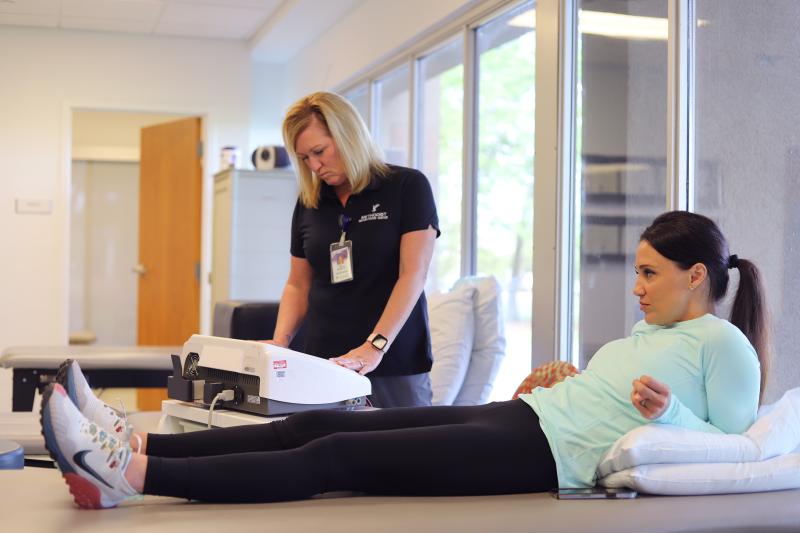Fourteen years ago, Amanda Dove Wells watched her father-in-law fight back from a near fatal helicopter crash.
Larry Wells broke 12 ribs, his right femur, his sternum, pelvis, tailbone, wrists and upper arms, vertebra in his back and right shoulder blade. “He was never supposed to walk again,” Amanda said.
Yet by the time he finished therapy at Methodist Rehabilitation Center in Jackson, he could even climb stairs. “We were talking about putting a ramp on the house, and the need went away,” said his wife, Donna.
Amanda’s father, John Dove, also recovered at MRC after suffering a spinal cord injury in 2014. So when she broke her pelvis and femur in a Dec. 14 car crash, there was no doubt where Amanda would do her therapy.
“I always knew I’d come to Methodist because both had such a great experience,” she said.
Amanda and her husband, Nathan, were heading home to Jackson after a trip to Memphis when their Yukon hydroplaned into a pine tree. Amanda’s right side bore the brunt of the impact, and her lower half was “beaten the hell up,” she said.
“Thankfully, we had a lot of people stop,” she said. “One was an off-duty EMT and another was a retired Air Force medic. She got in and stabilized my neck.”
Rescuers worked almost an hour to get her out of the crumpled vehicle using the Jaws of Life. Then, she was taken to Jackson via ambulance because bad weather had grounded helicopter transport.
She and Nathan were both sent to the University of Mississippi Medical Center in Jackson. They were separated in the ER, so Amanda was fearful about facing her treatment alone.
She needn’t have worried. Three of her best friends work at UMMC and were soon taking care of business. Meanwhile, her mother and mother-in-law arrived at her home to be with her three children.
Still, she had to overcome some scary moments on her own. “They had to put my leg in traction, and the surgeon got out what looked like a Home Depot drill and drilled into my knee,” she said. “I knew I could suck it up and get it over with or freak out.”
After surgery to repair her broken bones, Amanda stayed a week at UMMC. She spent another eight weeks letting her pelvis heal before hitting the gym at Methodist Outpatient Therapy in Flowood.
“I came first in a wheelchair, and I was hardly able to stand up,” she said. “I walked 20 feet on a walker, and it took 40 seconds.”
Now, she can do it in 16 seconds, but not everything is healing as quickly as she hoped.
Complicating her recovery is femoral nerve damage that prevents her from activating her right quadriceps muscle. “I can’t kick my leg out,” she said. “Telling your body to do something and it doesn’t do it—that’s new.”
Nerve injuries are notoriously slow to recover. “Nerves heal at about a millimeter a day,” said Methodist physical therapist Amy Burge. But Amanda has made progress with the aid of electrical stimulation therapy.
An example is the use of a wearable device known as the Bioness L300. Its low level electrical pulses help activate weakened nerves that control muscles in her upper leg.
Amanda used the Bioness while walking on an AlterG Anti-Gravity treadmill, which employs NASA-inspired technology to off-load as much as 80 percent of a user’s body weight.
“All the gear here blows my mind—the Bioness and the AlterG,” Amanda said.
During an AlterG session, Amanda’s lower body is encased in a waist-high plastic chamber filled with load-lifting, pressurized air. Treadmill controls adjust the pressure, creating a low-impact, workout zone where she can walk or run forward, backward or at an incline.
During a recent AlterG session, she managed to do 10 minutes of walking at 2 miles per hour while supporting 80 percent of her body weight.
It’s a welcome activity for someone as fitness-minded as Amanda. And the results are now visible. Burge said when she first began doing electrical stimulation on Amanda’s quadriceps, she couldn’t see any contraction. Now, Amanda’s able to initiate movement herself.
“A few weeks ago I was sitting in church just trying to contract the muscle, and it did kind of jump,” she said.
Until she can bend her knee again, Amanda’s walking ability is being enhanced by a brace called the Icarus. Relatively new to the market, it’s 3D-printed and extremely lightweight.
But what truly sets it apart is it provides up to 40 pounds of adjustable knee extension assistance, said Bret Lee, a certified orthotist/prosthetist at Methodist Orthotics & Prosthetics in Flowood who fit Amanda’s brace.
“She fit the profile for exactly what the brace is for,” Lee said. “Since she cannot extend her knee, she has nothing to help her get to a standing position.”
The brace also provides support to keep her knee from buckling while she’s walking, promoting a more natural gait.
It’s also helped her gain the confidence to embrace yet another challenge—driving again, despite her current limitations. For that she turned to Lisa Rials, an occupational therapist who is part of Methodist’s Driving Rehabilitation Program.
The program provides an evaluation of cognition, perception and motor response, as well as an in-vehicle assessment in various traffic situations. And Amanda passed the test on April 14.
“It’s like getting my driver’s license again at 16. It’s freedom,” she said.
The founder of The Tell Agency, a full service communications firm, Amanda began working from home in January—with a few modifications. “Sitting up all day is still hard on my pelvis,” she said. “By late afternoon, I have to lay flat with my laptop on my stomach.”
She said she’s fortunate to have a staff of eight who’ve kept things running at the office. And her family and friends have provided support, as well. Her father-in-law, in particular, has used his knowledge of rehab to anticipate her needs.
Even before she left the hospital, he had rounded up equipment to ease her transition home.
“He had found all this home health stuff I didn’t even know I needed,” she said. And he’s also been a wise counsel on the topic of pain management and the body’s ability to heal.
“I broke a couple of bones, and he broke most of the bones in his body,” she said. “That’s putting things in perspective for me.”
And lest she get discouraged, she has his outcome to inspire her. Despite the odds, he’s back in the air piloting fixed-wing planes for fun.




